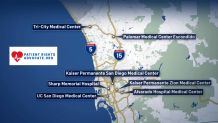Less than half of the hospitals in San Diego County, and less than a quarter of major hospitals nationwide, comply with federal laws designed to prevent patients from surprise medical bills, according to a report published last month by PatientsRightsAdvocate.Org.
The group conducts a semi-annual analysis of 2,000 hospital websites to see if health care companies are complying with the Hospital Price Transparency Final Rule.
The law, which went into effect in 2021, requires that:
- “Hospitals must display pricing information for at least 300 ‘shoppable services’ (or as many as the hospital provides if less than 300) that a health care consumer can schedule in advance. Must contain plain language descriptions of the services and group them with ancillary services, and provide the discounted cash prices, payer-specific negotiated charges, and de-identified minimum and maximum negotiated charges.”
- “Hospitals must publish a single machine-readable digital file containing the following standard charges for all items and services provided by the hospital: gross charges, discounted cash prices, payer-specific negotiated charges, and de-identified minimum and maximum negotiated charges.”
Get San Diego local news, weather forecasts, sports and lifestyle stories to your inbox. Sign up for NBC San Diego newsletters.
The main goal is simple: Consumers should be able to easily find out how much medical procedures or services cost before making a health care appointment.
“Sadly we’re over two years into this law and today it’s not working,” Cynthia Fisher, founder of PatientsRightsAdvocate.Org, told NBC 7 Investigates, “because most hospitals are not showing all of their prices.”
Out of 2,000 hospitals, the report says only 489 are currently compliant. Among those the report labels as out-of-compliance are seven hospitals in San Diego.
Local Hospitals Accused of Noncompliance with Federal Regulations
In its review, PatientsRightsAdvocate.Org looked at 13 of our local hospitals. Of those, it says seven were not compliant with the federal rule. Those include:
- Alvarado Hospital Medical Center
- Kaiser Permanente San Diego Medical Center
- Kaiser Permanente Zion Medical Center
- Palomar Medical Center Escondido
- Sharp Memorial Hospital
- Tri-City Medical Center
- UC San Diego Medical Center

PatientsRightsAdvocate.Org found each of these hospitals noncompliant for a variety of reasons. In some cases, it said a particular hospital didn’t include pricing information for all negotiated rates from individual health insurers and all associated plans a hospital accepts. In other cases, it said a hospital didn’t post discounted cash prices.
It’s important to note that the group also uses a data methodology that’s stricter than the federal rule when determining if a hospital is noncompliant. Often, a hospital’s standard-charges file will have fields of data marked: n/a, variable price, not reimbursed separately or be completely blank. If more than 50% of the fields are marked in this way, PatientsRightsAdvocate.Org says the hospital isn’t providing an adequate amount of information for consumers.
The health care system has benefited by keeping patients in the dark, hiding prices so they can charge whatever they want.
Cynthia Fisher, founder, PatientRightsAdvocate.Org
Fisher said the machine-readable file of standard charges is what has the biggest potential to shake up the health care industry,and finally give patients the upper hand.
“To be able to create mobile apps, online shopping tools like Priceline or Expedia or even Google search engines to show us what’s the price of an MRI within an hour radius — that’s how every other market works in our economy,” Fisher said.
You can see why the group says each of these hospitals isn’t meeting federal standards at the bottom of this article. We’ve also included responses from each health care company. With the exception of one, each hospital told NBC 7 Investigates it disagrees with the report and considers itself to be fully compliant with the law.
Only Palomar Medical Center Escondido acknowledged its website doesn’t currently have price transparency data. A spokesperson told NBC 7 that the hospital’s web server came under attack in January, forcing it to launch a new version of the website that was still under construction. It says the incomplete site that’s currently live does not contain pricing data but anticipates that it will be posted within three months. It says its actions to shut down the old site prevented any data breach.
Questions about Government Enforcement & Transparency
The Centers for Medicare & Medicaid Services is the federal agency responsible for enforcing the Hospital Price Transparency Rule. CMS Administrator Chiquita Brooks-LaSure told NBC Nightly News the agency increased the maximum fine for non-compliant hospitals from $100,000 to $2 million.
“We wanted to make sure hospitals knew we’re serious,” Brooks-LaSure told NBC.
So far, CMS has only fined two hospitals in Georgia for not disclosing prices.
“I think it’s possible that we have more fines,” Brooks-LaSure said, “but really what we prefer is to have the data available.”
CMS says it recently surveyed 600 hospitals and believes 70% were compliant with the pricing law. However, in a February blog post on healthaffairs.org, CMS acknowledged that its hospital analysis wasn’t as thorough as when it singles out a hospital for compliance, writing:
“...the results cannot be used to determine compliance with respect to every regulatory requirement, which often necessitates a more detailed analysis and direct interaction with the hospital, as occurs during a comprehensive compliance review.”
Fisher’s group says that’s why its analysis of hospitals doesn’t match the one conducted by CMS. She says most hospitals do have some pricing information online but says many sites are incomplete.
CMS says if hospitals disingenuously omit prices, they could face an investigation by the attorney general. Though Brooks-LaSure won’t say if that’s actually happened.
A CMS spokesperson declined NBC 7’s request for an interview about the San Diego area hospitals. The agency also won’t say which hospitals have been investigated, which have been sent warning letters and which have been sent correction action plans. In a written statement, the spokesperson only provided the below numbers:
- 600 warning notices were sent to hospitals nationwide
- 240 were sent corrective action plan requests
- 530 cases after hospitals corrected issues
Also in a statement, the spokesperson said the agency only names a hospital when it issues fines because:
“Releasing this information prematurely could identify hospitals that have already taken corrective actions and come into compliance after issuance of a warning letter, given the relationship in timing of our reviews and the hospitals being at various stages addressing compliance requests.”
Fisher says until CMS cracks down on hospitals, they’ll keep hurting the people they’re supposed to help.
“The health care system has benefited by keeping patients in the dark, hiding prices so they can charge whatever they want," Fisher said.
Alvarado Hospital Medical Center
PatientsRightsAdvocate.Org says this hospital is out of compliance because its “Standard Charges File fails to provide an adequate amount of gross charges and negotiated rates.”
In response, a hospital spokesperson told us, ”We have engaged extensively with Patient Rights Advocate, as have many hospitals, health systems, and industry groups such as the Federation of American hospitals, to dispute their findings because the Patient Rights Advocate report relies upon inadequate and cherry-picked data. In correspondence with Patient Rights Advocate, they admit that they do not apply the same standards as CMS and that CMS may come to different conclusions about compliance with the Price Transparency requirements, and in many cases, CMS has found hospitals in compliance even when Patient Rights Advocate claims they are not. As set forth in their report, Patient Rights Advocate relies upon an arbitrary mathematical formula by which any hospital that does not list gross charges and negotiated rates for at least 50 percent of the items and services identified is deemed to be non-compliant. This is simply not a requirement of any CMS Price Transparency regulation and we have explained to Patient Rights Advocate repeatedly that not every item or service has a gross charge or negotiated rate.
With regard to gross charges, we cannot list a gross charge for an item or service that has a variable cost, such as certain supplies and pharmacy items. Similarly, we do not have a fixed charge for DRG [diagnosis-related group] codes because all DRG charges are variable depending on the length of stay, complications, and other factors which impact the DRG. And with regard to negotiated rates, we do not have a negotiated rate for every item or service because many health plans do not separately pay for certain items or services and instead bundle the payment for those items and services. We are not missing any negotiated rates in our list and if there is no negotiated rate provided, that is because no negotiated rate exists. Patient Rights Advocate fails to acknowledge these basic facts about hospital charges and insists on using their arbitrary 50 percent mathematical calculation which is unsupported by the law. Moreover, CMS has recently released data directly contradicting the Patient Rights Advocate Report because the CMS conducted a review of 600 hospital websites in 2022 and found that 70% of hospitals were in compliance with both parts of the Price Transparency Rule, and 82% of hospitals were in compliance with at least one component of the rule.”
You can find pricing information on the hospital’s website.
Kaiser Permanente Zion Medical Center & Kaiser Permanente San Diego Medical Center
PatientsRightsAdvocate.Org says this hospital is out of compliance because its “Standard Charges File omits the de-identified minimum and maximum charges.”
In response, a hospital spokesperson told us, “Kaiser Permanente has complied with the required elements for price transparency. The Patient Rights Advocates group that conducted this survey is not a government entity with authority to interpret CMS requirements and erroneously categorized Kaiser Permanente as non-compliant for elements that should be deemed as non-applicable.
Kaiser Foundation Hospitals, including San Diego Medical Center & Zion Medical Center, contract exclusively with Kaiser Foundation Health Plan (KFHP) as a health plan, and so the hospitals hold no contracts with non-KFHP plans. For that reason, we include the KFHP Rates for inpatient and outpatient settings in our files as our negotiated rates. The tabs are labeled “Kaiser Plan Rates Inpatient” and “Kaiser Plan Rates Outpatient.” As a fully integrated system – health plan, hospitals, and contracted medical groups all under a common integrated health system, with no other contracted plans — the Kaiser Permanente Plan Rates are the Hospital’s negotiated rates. There are no negotiated plan rates that exceed or fall below the Kaiser Permanente Plan rates, so the de-identified minimums and maximums do not apply.”
You can find pricing information on the hospital’s website.
Palomar Medical Center Escondido
PatientsRightsAdvocate.Org says this hospital is out of compliance because its “Standard Charges File fails to provide an adequate amount of negotiated rates and fails to adequately identify specific plans for all commercial payers.”
In response, a hospital spokesperson told us, “On January 31, 2023, we were notified by the chief security officer of Palomar Health that a vendor’s server hosting that site was under attack and a data breach could occur. We were asked to immediately shut the site down in fear of any info leak, which there was none. We were then asked to go live with the new website, even though not complete, so there would be some information available on the Palomar Health website such as doctors, appt info, critical information, etc. The transparency pricing issue was not completely built yet, however is in the process of being built, anticipated to be complete and live in 3 months. As far as we know, we were in compliance prior to the emergency and immediate shutdown of the old website.”
You can find pricing information on the hospital’s website.
Sharp Memorial Hospital
PatientsRightsAdvocate.Org says this hospital is out of compliance because its “Standard Charges File fails to provide an adequate amount of negotiated rates.”
In response, a hospital spokesperson told us, ”Sharp HealthCare was reviewed by the Centers for Medicare & Medicaid Services (CMS) in March 2022 and found to be fully compliant with all federal Hospital Price Transparency regulatory requirements. Additionally, machine readable files are available to the public on sharp.com/patient/billing/pricing.cfm, with a separate file for each hospital facility. Regarding 3rd party insurer rates, not all rates are included due to the nature of some contracts not meeting the criteria for disclosure.”
You can find pricing information on the hospital’s website.
Tri-City Medical Center
PatientsRightsAdvocate.Org says this hospital is out of compliance because its “Standard Charges File fails to provide an adequate amount of negotiated rates.”
In response, a hospital spokesperson told us, “Tri-City Medical Center's website meets Center for Medicare and Medicaid Services (CMS) requirements for price transparency. As was the case for many hospitals, the relatively new price transparency law created new requirements that necessitated updates to hospital websites, ours included. We worked collaboratively with CMS, the agency responsible for such oversight, to bring Tri-City Medical Center’s website into full compliance with federal requirements for price transparency.”
You can find pricing information on the hospital’s website.
UC San Diego Medical Center
PatientsRightsAdvocate.Org says this hospital is out of compliance because its “Standard Charges File omits the discounted cash prices and fails to provide an adequate amount of de-identified minimum, maximum, and negotiated rates.”
In response, a hospital spokesperson told us, “We believe we are compliant. UC San Diego Health is committed to helping patients and their families make informed decisions about every aspect of their care, including the costs associated with the care they seek.
The Centers for Medicare and Medicaid Services (CMS) has created regulations that aim to support pricing transparency in hospitals nationwide. The first requirement is to provide a consumer-friendly list of estimates for 300 “shoppable services” that are typically scheduled in advance.
Additionally, to make this information accessible to patients, UC San Diego Health developed a price estimator tool that goes beyond the CMS requirements. This tool provides transparency to patients about real-world charges for their health care. Importantly, the tool enables any patient – current or prospective – to enter their specific health plan, to better estimate the expenses they could expect for their health procedures and services.
Regarding CMS’s requirement on fixed charges, most of our contracts establish the cost of a procedure or service terms that do not offer set or fixed prices for individual codes, but as a percentage of total gross charges. In such instances, the cost of one procedure or service would vary depending on the total gross charges billed for all care provided to that case. Other contracts include language of “not to exceed” or stop loss provisions that impact the final negotiated rate. The format required under the CMS provision does not allow for these types of variables. Although we could not generate a set dollar figure in such instances, we wanted to convey that a negotiated rate based on other criteria exists, so we populated those aspects of the spreadsheet with the term “variable.” Consistent with CMS guidelines, we have listed the fixed rates where possible and, where that is not possible, have listed them as “variable.”
We encourage patients who have questions about their potential hospital charges to contact us for individualized estimates. We have a team of financial advisors available to help with estimates of potential financial responsibilities, provide financial assistance and discounts for patients who have no insurance or, for patients who qualify, help them enroll in available government programs.”
You can find pricing information on the hospital’s website.



